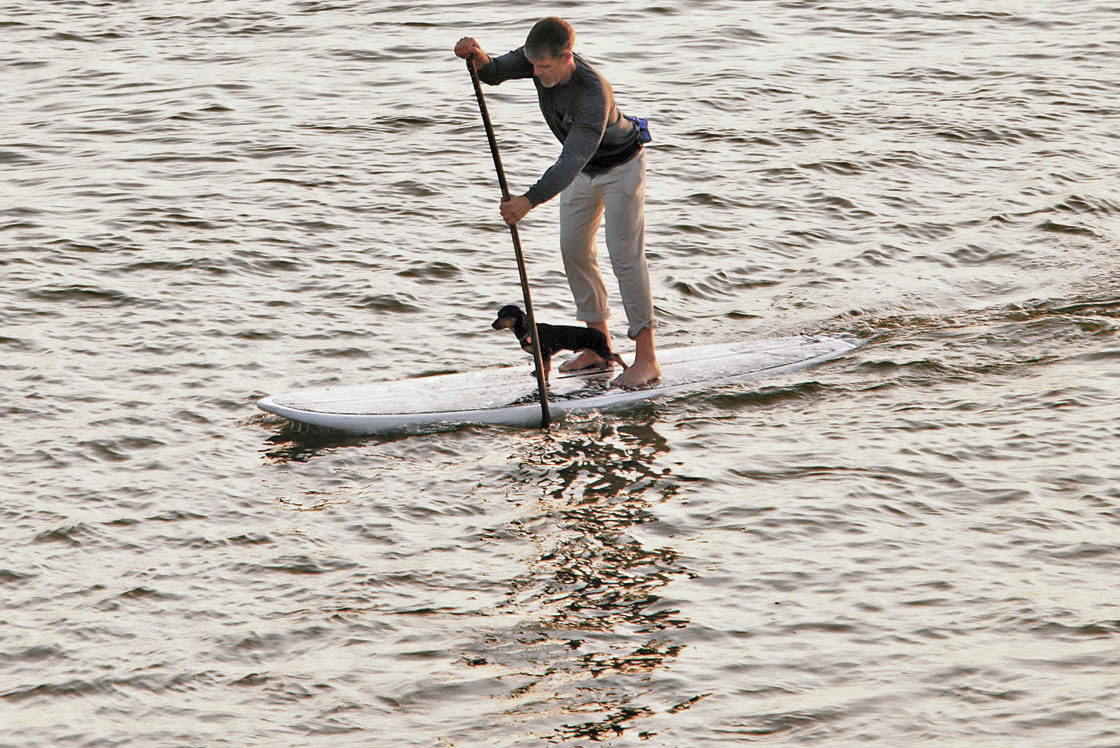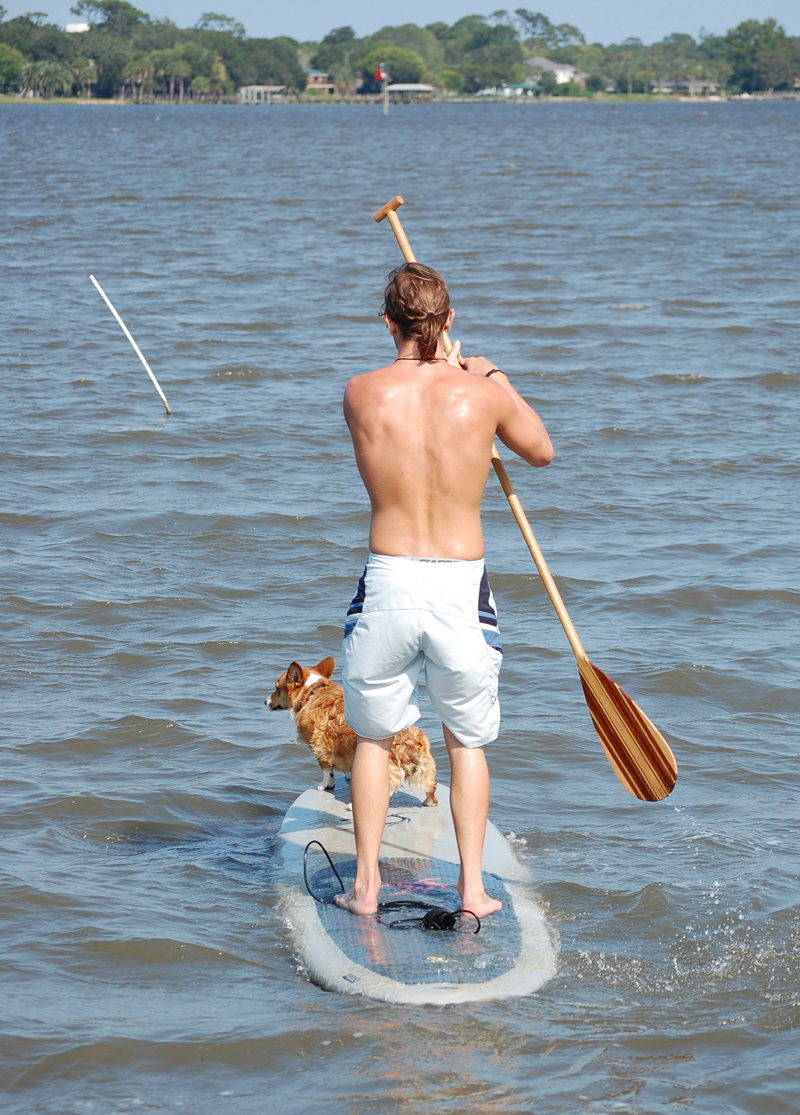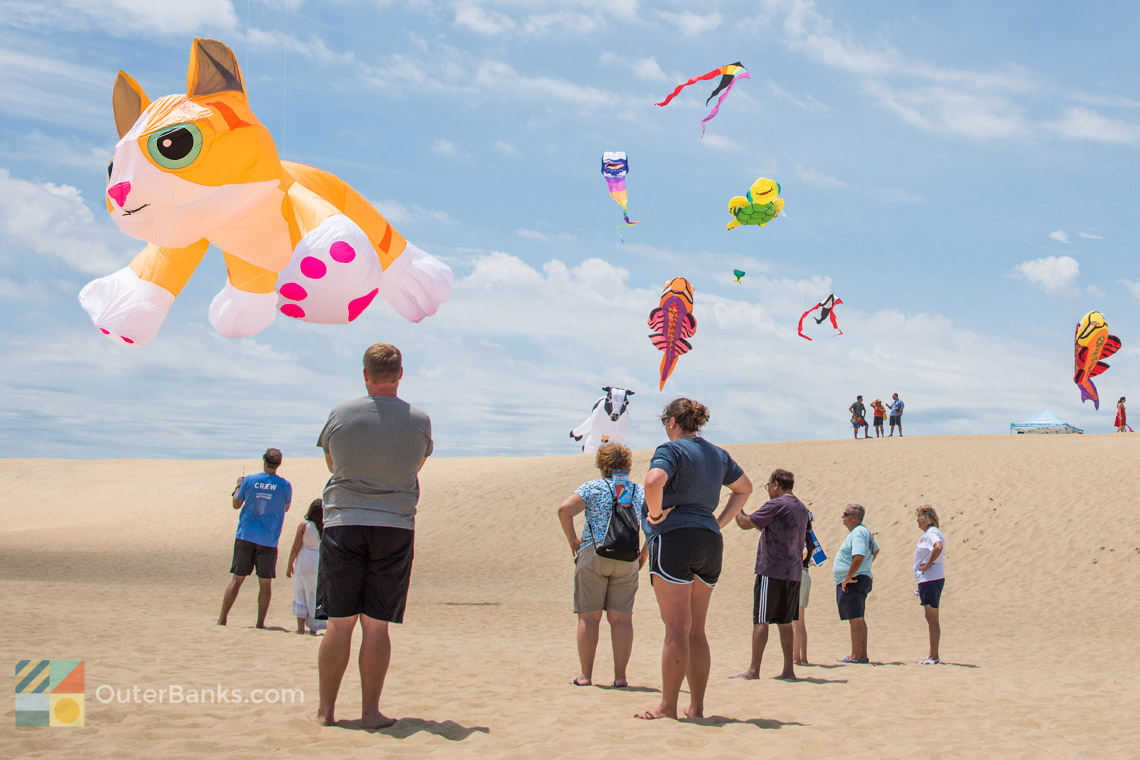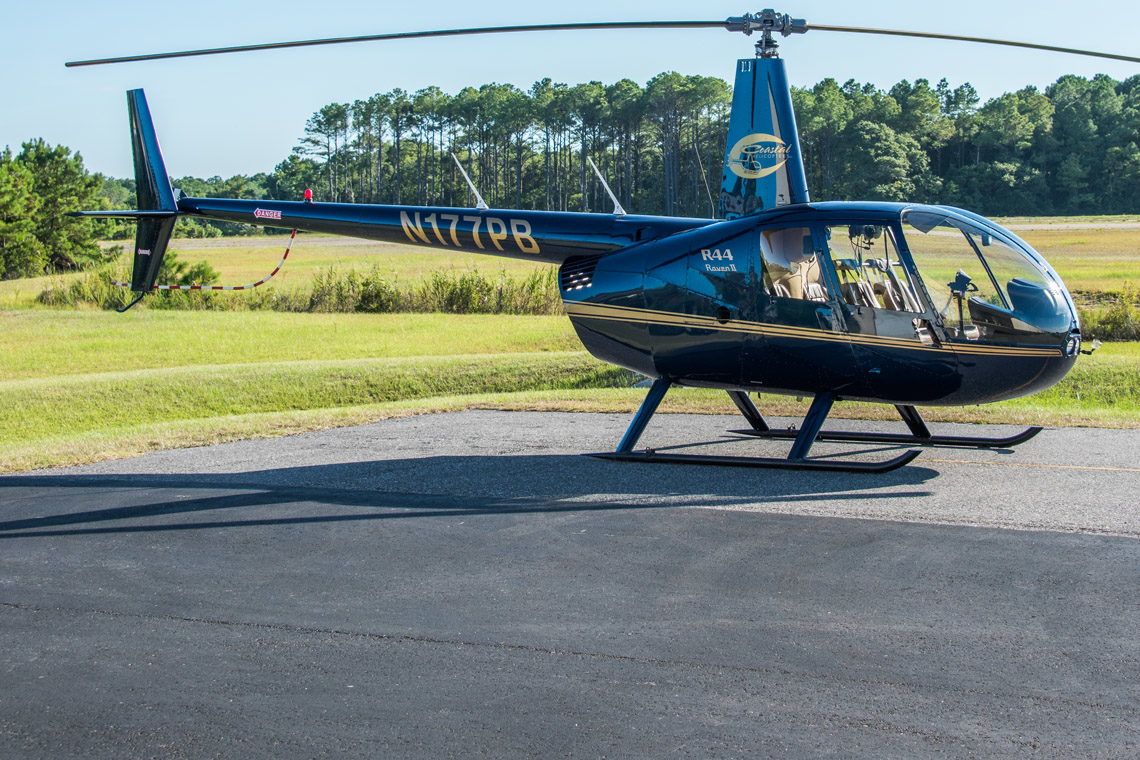SUP Guide Sections:
Stand-Up Paddle Boarding (SUP) may be considered one of the Outer Bank's newest crazes to hit the water, but the sport itself is actually centuries old, originating in the Hawaiian and Polynesian Islands as an easy-going mode of transportation from one waterfront beach to another.
On the Outer Banks, the sport has exploded in recent years, thanks to both the sport's diversity and simplicity. Basically anyone can pick up a board and a paddle, find a stretch of oceanfront or soundfront water, and start slowly meandering across the gentle ripples, or ride a paddle board along fast-moving waves.
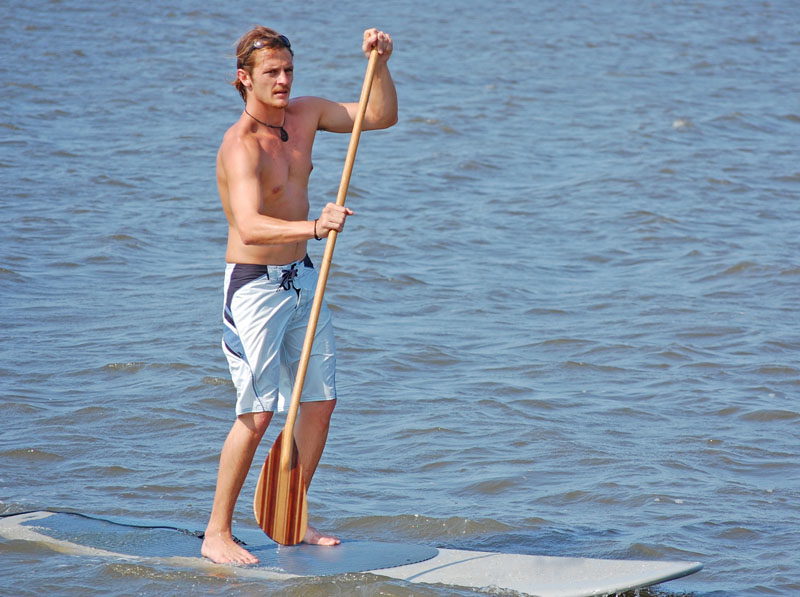
Easy for newcomers and water lovers of all ages, paddle boarding has clearly stormed the beaches of the Outer Banks. Try something new on your next beach vacation, and give paddle boarding a test drive.
Where to Go Paddle Boarding
There is an endless supply of launching points for Stand Up Paddle Boarding on the Outer Banks. Many vacationers find that a soundfront or canalfront vacation rental home can serve as the perfect launching point, as all a paddle boarder has to do is head to the backyard and get in the water. For vacationers with off-the-water accommodations, there are plenty of public launching points as well.
In the Northern Outer Banks, visitors can roll over to the Currituck Heritage State Park in Corolla or to the Duck Town Park or soundside harbor front for miles of access to the Currituck Sound. The sound waters on the Outer Banks are ideal for beginners, especially on calm days with winds of 10 mph or less.
Even on the sound, however, paddle boarders should use caution on exceptionally breezy days when even the gentle shallow waters of the sound can be deceptively rough, with strong currents waiting just beneath the surface. On these super windy days, it's fine to paddle board, but it's best not to explore too far and to stick close to shore.
Public sound accesses are also available in Kitty Hawk and Kill Devil Hills, particularly near the Kitty Hawk Sate Reserve. For easy-going rides, SUP lovers can also try out the network of soundside canals in Colington Harbor, which lies west of the main drag of Kill Devil Hills and offers a scenic series of waterfront residential communities, bordering bulk headed saltwater canals.
In Nags Head, water sports abound in Jockey's Ridge State Park, and SUP riders can paddle out accompanied by dozens of kite boarders, wind surfers and kayakers. With a nice wide soundfront beach and miles of the Albemarle Sound to explore, there's generally enough room for water riders of all kinds, but use caution when paddling around speedy kite boarders or windsurfers. While a paddle boarder can easily explore the park at a leisurely pace, kite boarders and windsurfers may have slightly more trouble slowing down and avoiding a collision.
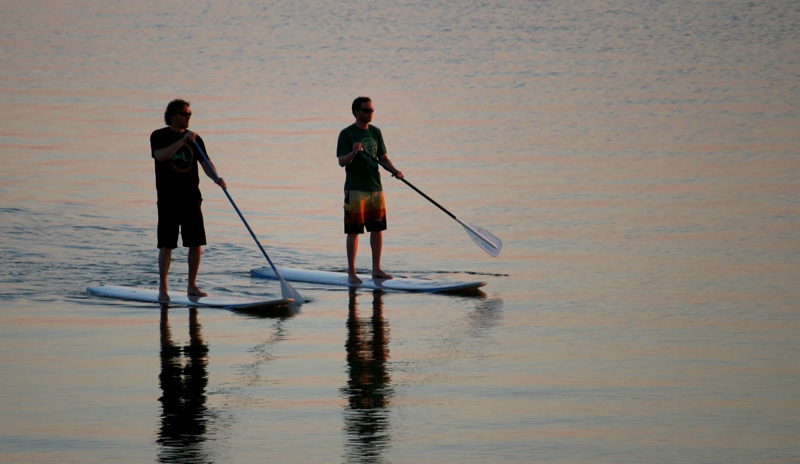
Hatteras Island has countless launching points, from the small jetties bordering the south side of the Bonner Bridge to the lightly populated marinas and canals in Hatteras Village.
Paddle boarders in particular may want to explore the "New Inlet," located just a few miles south of the Bonner Bridge. This small soundside public parking area borders a now abandoned original bridge that skirts across a section of the Pamlico Sound. Originally acting as the main inlet between Hatteras and Bodie Islands, the "New Inlet" closed up after Oregon Inlet was cut through during a 1922 storm, and today simply serves as an unpopulated and scenic sound access point. Bordering the Pea Island National Wildlife Refuge, the New Inlet location gives paddle boarders a gentle ride as well as some spectacular bird watching.
Another good location is the Salvo Day Use Area, which lies on the southern outskirts of Salvo Village. This wide soundside parking area features seasonal restroom facilities and picnic areas, and is a popular destination for all Pamlico Sound-based water sports. Further south, water sports lovers of all kinds also congregate at world renowned Canadian Hole, another soundside beach and parking area that lies directly in between Avon and Buxton Villages. For more of a challenge, hop across NC Highway 12 to the oceanside, where the ocean waves can provide a tricky ride to even the most skilled SUP riders.
For paddle boarding newcomers who want to try out wave riding, the beaches of Frisco and Hatteras Villages are ideal. With gradual sand bars that allow small, slow waves to break well offshore, these beaches are virtually designed for ocean-oriented SUP. The shallow, gradual slope ensures that walking out into the ocean is a breeze - no paddling required - and the small and consistently gentle waves provide long fun rides, without the risk of getting wiped out.
Ocracoke Island's beaches are incredibly similar, with the majority of the shoreline consisting of gradually sloping shoreline. There are also a number of sound access points along NC Highway 12, and nature lovers will want to make the quick mile hike through Springer's Point in Ocracoke Village, for a soundfront beach with a front row view of the passing ferry and boat traffic.
Regardless of where your paddle boarding adventures take you, there are a few factors to be mindful of before hitting the water.
- Watch out for currents, on both the ocean and sound sides. Breezy days with gusts of 20 mph or more can lead to rough rides on the sound, and rip currents can quickly pop up in the ocean, carrying even the most experienced rider and their board out to sea. For rip currents, look for unusual patterns in the ocean waves, with the illusion of some water or waves being "pushed out" from the beach. Also, keep a keen eye on the weather for any rip current threats or high wind advisories in the area.
- Steer clear of inlets, like Oregon Inlet, Hatteras Inlet, and Ocracoke Inlet. Even on the calmest days, when the sound and ocean water mixture looks quiet and still, deep currents rush through these waters up to 20' feet deep, and can be impossible to paddle through.
- Use caution in heavily populated water sports areas, like Jockey's Ridge or Canadian Hole, and be on the lookout for other riders, including kite boarders and windsurfers. Use extra caution when paddling near marinas or other high boating traffic areas, where a paddle boarder might be harder to spot by the larger vessels cruising by.
- Load up on waterproof sunscreen before your ride. A life vest may also come in handy for new paddle boarders in deeper areas of water.
Paddle Boarding Equipment and Rentals
Though virtually unheard of just a decade ago, today Paddle Boarding Equipment can be purchased at most local Outer Banks water sports shops that sell kite boards, surfboards, and most any water sports equipment.
Real Kiteboarding and Kitty Hawk Kites, two of the most far-reaching water sports companies on the Outer Banks, both have equipment on hand, and even local rental companies, such as Moneysworth Rentals and Ocean Atlantic Rentals, have hopped on board the trend and offer weekly or daily equipment rentals for vacationers. (Tip: For visitors who might not have the car room to haul the paddle boards homes, many local rental companies can also deliver equipment, including boards and paddles, right to your vacation rental.)
Paddle Boarding Lessons
Like all Outer Banks water sports, where there's a will, there's a way, and new riders have their pick of Stand Up Paddle Boarding lesson providers from Corolla to Ocracoke. Sup beginners can choose from small, locally run businesses, or larger nationally-known companies, as well as individual training lessons or group SUP outings.
Lessons generally last from an hour to 90 minutes, as that's basically all a newcomer needs to get the hang of the sport. Unlike other popular water sports, paddle boarding can be picked up in a lesson or two, and after acquiring the basics, a boarder can experiment with maneuvering and techniques on their own. Best of all, all age levels can quickly adapt to the easy basics of paddle boarding, making a family lesson an ideal group vacation activity.
Be sure and call or reserve ahead as the popularity of paddle boarding shows no signs of slowing, and try to schedule your first lessons for a less-windy, calm day, (usually any summer day will do), when the basics of standing and paddling through the water are easiest to master.
Stand Up Paddle Boarding has exploded on the local Outer Banks water sports scene, and it's easy to see why. Accessible for everyone, with easy fundamentals and not much equipment, SUP is a water sport that vacationers of any skill level can quickly adapt to. In addition to the ease of the sport, the Outer Banks is an expansive waterfront playground for paddle boarders, with challenging ocean waves and gently flowing sound waters, allowing riders to adapt their SUP adventure to their own unique style.
Whether you'd prefer to glide along and take in the gorgeous local scenery, get a sturdy workout while exploring the sound, or master your balance on the ocean waves, Stand Up Paddle Boarding is a sport where everyone can get on board.
General stand Up Paddle Boarding (SUP) Information
Unlike a number of other popular Outer Banks sports, like kiteboarding, windsurfing, or hang gliding, paddle boarding does not require a lot of expensive or complicated equipment. As the name suggests, all a rider really needs is a standard paddle board and a paddle in order to delve into the sport.
A typical paddle board is between 9' and 12' feet long, with the shape and formation of a surfboard. The body is slightly wider to allow for easier rider maneuvering, and typically has between 1 and 3 fins for speed and ease of use in the water. The "paddle" resembles a long kayak paddle, allowing the rider to dip it into the water from a standing position.
Once this equipment is obtained, all a rider has to do is find some open water to explore. Thankfully, on the Outer Banks, this is never a problem. There are literally miles of sound, ocean, and saltwater canals to explore, and as a result, a paddle boarder can easily decide the "style" of SUP they want to enjoy.
For a fitness-oriented paddle or just an easy ride, the Currituck, Albemarle, Pamlico and Roanoke Sounds offer miles of peaceful, easy-to-ride water. For more of a challenge, and more of a surfing vibe, a paddle boarder can hit the beach and try to ride the ocean waves onto shore. Regardless of what your ideal SUP experience looks like, the Outer Banks has plenty of water for cruising.
Before you hit the water, paddling out can be a useful skill, particularly in the ocean where shore breaks may hinder a surfer from getting out to the better, offshore waves. To paddle out, simply lay on your stomach on the board, and paddle your arms in a freestyle stroke, alternating on either side of the board. Experienced paddle boarders will "duck dive" under waves that are about to crash, or basically tip the paddle front-first into the water to avoid being crushed by the white wash. For newcomers, bear in mind that soundfront launching points, particularly in areas where the sound waters are shallow, require no paddling at all - just a simple hop on the board.
Once you're on board and standing up, all it takes to glide through the water is to alternatively paddle from side to side in long deep strokes with the paddle about 6" to 12" in the water. Paddling on just one side will enable the rider to turn, and when riding waves, the rider simply get a paddling start and hang on. In essence, the motions are similar to kayaking, but with the rider upright instead of sitting down, giving a paddle boarder a phenomenal, low-stress workout for the arms and the body.
-
OBX Wedding Fest
January 16th, 2026 - January 18th, 2026 -
Hatteras Island Oyster Roast
February 7th, 2026 1:00 PM - 4:00 PM -
First Friday in Manteo
March 6th, 2026 6:00 PM - 8:00 PM
Shelling, Snorkeling, Paddle Boarding, Eco Tours & Light Fishing. Guided family adventure trips on Hatteras Island, NC. We take your group to multiple tidal islands along the Cape Hatteras seaside. These islands are constantly changing and...
Many newcomers to the Outer Banks find the best way to delve into the local history, scenery and culture is via a tour, and luckily the Outer Banks has a world of different tours available. Vacationers can take to the sea, skies, or the land for an...
QUALITY YOU CAN SEE, FRESHNESS YOU CAN TASTE! Every cup made to order with the freshest ingredients and handcrafted loose leaf tea brewed to perfection! Combining all the natural gifts from mother nature!
Most all visitors to Corolla will spend at least a sunny afternoon or two at the Historic Corolla Park. This 39 acre site is home to three of the Northern Outer Banks' biggest attractions, the Whalehead in Historic Corolla, the Currituck Beach...
